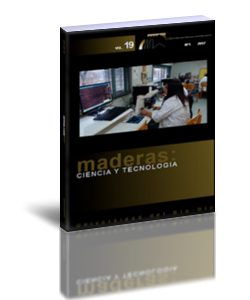Color and gloss evaluation in decorative stain applied to cases of Pinus radiata wood treated with copper azole micronized Type C
Keywords:
CIELAB coordinates, radiata pine, wood decorative coating, wood preservatives, wood impregnated.Abstract
Six treatments (one control and five decoration coatings) were applied to radiata pine wood treated with micronized copper azole for outdoor use at a rate of 3,08 kg/m3 retention. One decoration coating was applied prior to impregnation, prestain and two decoration coatings were applied in a mixture with the micronized copper azole preservative Black Cylinder and Red Cylinder. The following two varnishes were tested: a water-based varnish and a solvent-based varnish.Additionally, untreated radiata pine specimens were tested as a reference. The changes in the gloss and color of these five decorative coatings were evaluated after undergoing natural aging tests for three months and accelerated aging trials during exposure to ultra-violet radiation of 340 nm for 500 hours. In the accelerated aging trials treatments, changes in gloss and color showed the lowest variations in treatment trials prestain and Black Cylinder and the highest variations in treatment trial Red Cylinder. In the aging tests trials, changes in gloss and color showed the lowest variations in treatment trials prestain and Black Cylinder. The costs of each decorative coating were assessed in terms of performance according to timber volume coated. The lowest cost of the three decoration treatments was prestain, with a value of 16 US$/m3, followed by Black Cylinder with a value of 24 US$/m3. Compared with the alternative siding products available in the market, such as fiber cement and vinyl siding, colored wood treated with prestain is competitive with vinyl siding, with 58% lower costs than fiber-cement.
Downloads
References
Archer, K.; Peston, A. 2006. An overview of copper based wood preservatives. Wood protection, http://www.forestprod.org/woodprotection06archer.pdf.
AITIM. 2012. News of the wood protection. 62nd Assembly of European industrial sector of wood protection Technical Bulletin Nº272, p. 42-45.
Asociación de Investigación técnica de las Industrias de la Madera. AITIM. 2008. Coloring wood in autoclave. Technical Bulletin No. 253, page 25.
Asociacion Española De Normalizacion y Certificación. AENOR. 1997. Paints and varnishes. Coating materials and coating systems for exterior wood. Part 3: Test of Natural Aging. EN 927-3.
Asociacion Española De Normalizacion y Certificación. AENOR. 2002. UNE-EN-ISO 11507. Paints and varnishes. Exposure of coatings to artificial aging. Fluorescent exposure to ultraviolet radiation and water (ISO 11507: 1997).
Baines, EF. 2005. A review of the current status of the estimation of emissions from preserved wood and their use in the environmental risk assessment of wood preservatives under the Biocidal Products Directive. Document No. IRG/WP 05-50224-7. International Research Group on Wood Preservation, Stockholm, Sweden
Cui, W.; Kamdem, P.; Rypstra, T. 2004. Diffusse reflectance infrared Fourier transform spectroscopy (DRIFT) and color changes of artificial weathered wood. Wood Fiber Science 36:292-301.
Dieguez, M.J. 1994. Lasures, protectors of the wood. Interbimall magazine.Tech. bulletin of AITIM, Spain. pp. 47-51.
Dieguez, M.J. 1997. Finished of wood. Duration to the outside and vitreous transition temperature. AITIM 186. March /April. pp. 60-64.
Feist, W.C.; Hon, D.N.S. 1984. Chemistry of weathering and protection. In: The chemistry of solid wood, R.M. Rowell, ed. Advances in chemistry series 207, Am. Chem. Soc., Washington D.C.USA.
Garay R.; Henríquez, M. 2012. Tratamiento químico de acetilación en madera de Pinus radiata. Maderas-Cienc Tecnol 14(1):103-113.
Garay, R.; Henríquez, M. 2010. Comportamiento al fuego de tableros y madera de pino radiata d. Don con y sin pintura retardante de llama. Maderas-Cienc Tecnol 12(1):11-24.
Garay, R.; Poblete, H.; Karsulovic, J.T. 2009a. Evaluation of oriented strandboard and plywood subjected to severe relative humidity and temperature conditions. Forest Prod J 59(3):84-90.
Garay, R. 2009b. Effect of two Guards Surface Properties Wooden boards, after a year of exposure to the elements. Información Tecnológica 20(4):123-130.
Garay, R. 2009c. Propiedades de tableros estructurales contrachapados y OSB intemperizados durante dos años. Agro-Ciencia 25(1):20-32.
Garay, R.; Ahumada, I. 2008. Comparación de propiedades de suelos laminados. Boletín de Información Técnica 252:26:29. Revista AITIM. España.
Garay, R. 2007. Impregnantes tipo lasur para la protección de la madera y tableros. Agro-Ciencia 23(1):25-36.
Ghosh, M.; Gupta, S.; Kumar, V.S.K. 2015. Studies on the loss of gloss of shellac and polyurethane finishes exposed to UV. Maderas-Cienc Tecnol 17(1):39-44.

































